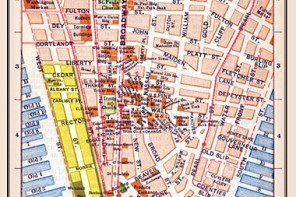As a historian, I regard lower Manhattan as something akin to sacred ground—not simply because of the awful tragedy that took place there on a crystalline September morning a decade ago or because of some explicit religious valence associated with that place. Lower Manhattan is “sacred” because, throughout American history, this has been the proving ground for our highest ideals as a people and as a nation: our tolerance and embrace of diversity.
Consider. Nearly a century Giovanni da Verrazano, an Italian immigrant in the service of France, discovered the inlet into New York Harbor, Henry Hudson, an Englishman under contract to the Dutch East India Company, nosed the Half Moon through the same Narrows and struggled north on the river that now bears his name. The first group of settlers to embark on Manhattan were Walloons (French-speaking Belgians), followed shortly by a modest influx of Dutch, Germans, and French. English Puritans bracketed Dutch settlement to the north and east, in New England and Long Island.
African slaves began arriving in the 1620s, and twenty-three Sephardic Jews, refugees from Recifé, came to New Amsterdam aboard the Sainte Catherine in 1654. Early reports filtering back to the Netherlands, the most tolerant society of the seventeenth century, told of Huguenots, Mennonites, Brownists, Presbyterians, Quakers, Catholics, even “many atheists and various other servants of Baal.” The Jews proposed to erect a synagogue, and French Jesuits from Canada mounted several missionary sorties among the Indians. Many colonists blamed the slave uprising of 1712 on Elie Neau, a Huguenot-turned-Anglican and an early advocate for abolition who ran a school for Africans in New York City.
Roman Catholics arrived in greater numbers in the nineteenth century, from places like Ireland, Germany, and Italy. As with other groups, finding their place in the rich tapestry of American diversity did not always come easy. John Hughes, who became the first archbishop of New York (and the founder of what is now Fordham University), protested the use of the Protestant-inflected King James Version of the Bible in the city’s public schools. His objections prompted the “great school wars” of the 1840s, when Protestants threatened Catholics and their churches. Hughes made his case for toleration by appealing to the United States Constitution and to Americans’ better selves: “Is this state of things, fellow-citizens, and worthy of you, worthy of our country, worthy of our just and glorious Constitution?
The vicinity of lower Manhattan was also the venue for signing of one of the most significant pieces of legislation in the twentieth century. At Liberty Island on October 3, 1965, Lyndon Johnson signed the Hart-Cellar Act, which removed the immigration quotas established by the Johnson-Reed Act of 1924 and once again opened the United States to immigrants. The legislation, the president declared in the shadow of the Statue of Liberty, “corrects a cruel and enduring wrong in the conduct of the American Nation.”
Whether they knew it or not, then, the terrorists who guided those fuel-gorged jets into the World Trade Center were targeting the very heart of America—not because of the buildings’ association with business or commerce, but because their location in lower Manhattan has long symbolized America’s noblest ideals.
Our response in the decade since 9/11 has been spotty at times but generally consistent with those ideals. On the negative side of the ledger, Muslims have sometimes been targeted, and a cynical president used the attacks as a pretext to rush the United States into two irrelevant and ill-considered wars. And surely the most reprehensible consequence of 9/11 was the use of torture against those the president deemed “enemy combatants.”
But Americans themselves, sooner or later, rise to their better selves and come to embrace the principles of toleration and respect for minorities encoded into our charter documents and symbolized by that tiny parcel of land in lower Manhattan. Not universally, to be sure, and far too belatedly in the case of women and racial minorities, but we Americans generally come around.
The proposed Islamic cultural center, Park51, provides a case in point. Initially derided as the “Ground Zero Mosque,” even though it was not primarily a mosque and it wasn’t at Ground Zero, Park51 has gradually won acceptance. Perhaps we should read some significance into the fact that the loudest critics of Park51, notably Sarah Palin and Newt Gingrich, are not New Yorkers and represent a political movement not generally associated with the rights of minorities.
The most ringing defense of the proposed Islamic center came from Michael Bloomberg, the mayor of New York and a Jew. “We would betray our values—and play into our enemies’ hands—if we were to treat Muslims differently than [sic] anyone else,” the mayor declared. “In fact, to cave to popular sentiment would be to hand a victory to the terrorists—and we should not stand for that.”
Well said—and utterly consistent with the rich history of toleration and multiculturalism associated with the “sacred ground” of lower Manhattan.



